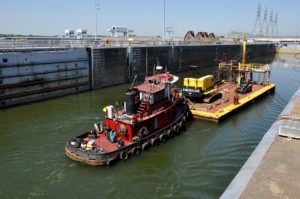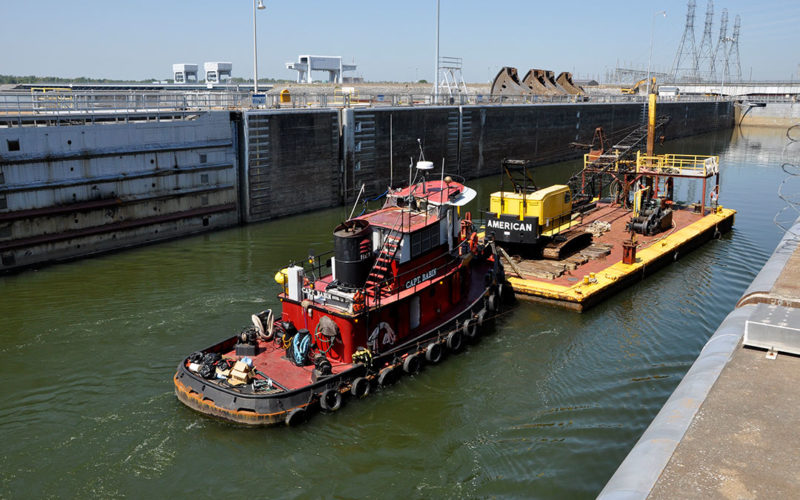
After finishing his T-bone, Capt. David Stansbury went to bed. Jackson “Bubba” Walker, the pilot, sat before the stainless-steel levers that controlled William Hank’s rudders, preparing to “make the lock.” Walker, a fifth-generation towboater, could remember floating past No. 52 on the Ohio River in the pilothouse of a towboat captained by his father. As the chambers filled and emptied and filled again, Walker smoked cigarettes and squinted through his glasses at the dam. Finally, William Hank was cleared to approach the lock. Walker pushed the throttles forward and the boat chugged slowly toward the narrow concrete wall.
In front of him at the head of the tow, a deck hand guided him in over the radio: “All right, Bubba, sitting down here about 1,000 (feet) below … four more feet you be looking at daylight on that long wall … points comin’ to the good, about a foot or two to the good.” The voice drawled in rhythmic monotone. “To the bad” meant Walker was going to hit the lock. “To the good” meant he was clear. The pilot had eased in close to the shore early in his approach to avoid being caught in a slide that might ram him into the bank or the lock. With the power of 4,200 horses, he was driving something longer than the Chrysler Building is tall. He wanted to get it right the first time.
Walker maneuvered William Hank snugly into the 1,200-foot chamber, a “temporary” addition built in 1969 to help No. 52 accommodate bigger tows. Instead of a smooth wall, the chamber was made out of poured-concrete cylinders encased in rusty sheet piles. The setup almost seemed designed to catch the front of a barge. “You can easily get quartered just enough that you can jam up in here and do a bunch of damage,” Walker said, laughing. His tow was 105 feet wide, the lock chamber was 110. To park his 1,130-foot tow, he had as much wiggle room as a car in a Walmart parking lot.
Gently tapping the rudder levers and pulling back and forth on the two throttles, Walker steered, came ahead and stopped in the center of the chamber. An operator in a neon-green vest appeared. He rode a yellow scooter to the end of the chamber wall, got off and leaned bodily against a long metal lever. The lock groaned. Its sector gears turned, its strut arms stretched out, and its miter gates slowly closed behind William Hank. A lock operator could close the gates and fill or empty the chamber by himself, using the levers and a set of buttons inside two sheet-metal shacks a little bigger than Porta Potties. At a newer lock, it might have taken 15 minutes to move a tow through, but so much water leaked out of No. 52 that it took an hour.
That made nine, since William Hank had waited eight hours to get here. “This is one of the fastest I’ve seen it,” Walker said. “I have actually sat on both sides of this lock for a week.”
•••••••••••••
The sun had set, the infamous lock was behind them, and Capt. Stansbury was back in the pilothouse, guiding the towboat as it churned up the Tennessee River. Walker had taken it up to the Paducah waterfront, where the crew exchanged a few barges and took on fuel and water. Stansbury’s craft was still 1,130 feet long — 247 feet longer than Titanic. To steer, he focused on a blue light on the jack staff, three football fields in front of him on the head of his tow.
A harvest moon rose from behind the woods. Stansbury turned off his spotlights and steered by the moon alone. At 10 p.m. he was approaching Kentucky Lock and Dam, the last control structure on the Tennessee River and another bottleneck. Over the past 130 years, barges and towboats have gotten a lot bigger, but the chamber at Kentucky Lock was 600 feet by 110 feet, the same size as the first lock chamber ever built on a major American river. As Stansbury neared the lock, 10 other towboats were lined up ahead of him. Because the chamber was small, most would have to break their raft of barges in half and lock through twice — a three-hour process. William Hank, its crew and the millions of dollars’ worth of goods it was pushing were looking at a 27-hour wait.
A larger lock chamber has been under construction here since 1998. The projected cost, revised upward several times, tops $1 billion. The U.S. Army Corps of Engineers maintains all of the navigation infrastructure on the inland waterways and designs and builds improvements, but money for these projects comes from Congress and from a special tax on gas burned by towboats. Before 2016, there weren’t enough gas tax funds to efficiently finance the Kentucky Lock addition. In 2013 and 2015, it received no money at all. By the latest estimate, the newchamber will be operational in 2023. Until then, tows will have to keep waiting.
“This industry, people just don’t see it every day,” Stansbury had said earlier. “They don’t understand where a lot of these products come from that they use every day. If the public was aware of the commodities we push, we’d probably get more funding. The squeaky wheel gets the grease.” It was easy to see why the river didn’t squeak. Beyond the pilothouse windows there were no lights for mile after mile. With few towns and fewer homes, no one saw what happened here. Practically the only lights Stansbury passed came from dry docks, coal terminals and chemical plants. Compared to roads, where the average American drives 11,498 miles a year, rivers are almost invisible.
Stansbury listened with amusement as the lock operator, overwhelmed by unseen voices from unseen towboats waiting in the blackness, called out over his radio to reassure each one of its place in line. After securing his spot, the captain nosed William Hank into the bank for the night. Throttles a touch forward, rudders turned just a little, he could wait indefinitely without tying up. Fog rolled in and soon he couldn’t see the head of the tow. Stansbury had stood the front watch. His six hours were almost up. Walker was awake, brewing coffee under a dim red light. It could take five days to move 100 miles on these stretches of the Tennessee and Ohio rivers. Stansbury would sleep six hours and be back on watch before his boat moved again. •
Editor’s note: Lock No. 52 and Lock No. 53 on the Ohio River were replaced by the Olmsted Locks and Dam, which opened in 2018.
Excerpt from Holding Back the River: The Struggle Against Nature on America’s Waterways. Copyright © 2021 by Tyler J. Kelley. Published by Avid Reader Press a division of Simon & Schuster

